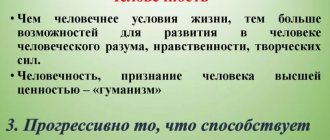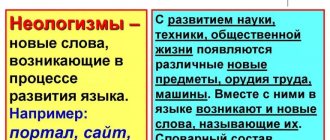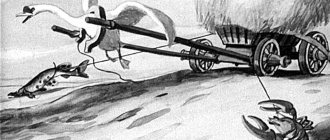Hello, dear readers of the KtoNaNovenkogo.ru blog. All of us in our lives have said or heard similar expressions at least once (and some more than once): YOU ARE ALWAYS LATE or HAVEN'T SEEN SEEN FOR A HUNDRED YEARS.
And few people thought that these phrases were devoid of any common sense. So, a person simply cannot “always be late.” And it’s impossible for someone not to see each other for “a hundred years,” if only because people rarely live that long.
Such exaggerations in Russian are called hyperboles and they will be discussed in this publication.
Hyperbole is a beautiful exaggeration
This word itself is Greek - “hyperbole” and it means “excess, excess, exaggeration.”
Hyperbole is one of the means of enhancing emotional assessment, which consists in excessive exaggeration of any phenomena, qualities, properties or processes. This creates a more impressive image.
Moreover, exaggeration often reaches completely incomprehensible concepts, sometimes even bordering on absurdity. Any foreigner, if he were to translate such phrases literally, would be clearly puzzled. We have long been accustomed to them, and perceive them as completely normal.
Here are examples of the most commonly used hyperboles in everyday life:
We constantly use all of the above expressions in colloquial speech. And for the sake of experiment, just try to parse them verbatim and see how funny and sometimes absurd some of them are.
Well, for example, “at least fill yourself up” - this should be such an amount of liquid that it is enough for a whole pool into which you could plunge headlong. Although in fact, with this expression we just want to say that we have a lot of drinks - even more than we need.
Or the phrase “a lot of money” actually just means a good financial condition, and not that a person has collected all his savings and let’s put them in one pile.
- What is grotesque in literature and examples of its use
And we do not use the expression “to travel a thousand kilometers” when we are talking about a real distance, for example, from Moscow to Volgograd or Rostov-on-Don. But simply in the sense of “far”, although in fact in real numbers the distance there may be only a few kilometers.
» alt=»»>
And this way you can “debunk” absolutely any hyperbole. But you shouldn't do this. They do not have to mean the absolute truth; their task is to characterize a specific situation or thought in the most picturesque way, enhancing its emotional coloring.
The reason for hyperbole
It's hard to imagine that the need for extreme exaggeration dates back to ancient times. The judgments of people in modern society are strikingly different from the worldview of ancient people who had completely fantastic ideas about the world. In those distant times, people could not have a clear understanding of what fiction and reality are. The most ancient people endowed with magical powers those phenomena that could not be explained. They were afraid of such phenomena. As a result, they began to appear
- Gratitude,
- astonishment,
- admiration,
- exaggeration.
Examples of hyperbole in fiction
In fact, such exaggerations are a very old literary device. It was used in Russian epics, and this was almost a thousand years ago. With the help of hyperboles, the strength of the heroes and their opponents was repeatedly strengthened.
The heroic sleep lasted 12 DAYS (well, a person cannot sleep for almost two weeks)
Countless forces stood in the way of the hero - A WOLF WILL NOT OUTRUN THEM IN A DAY, A RAVE WILL NOT FLY FROM THEM IN A DAY (how many enemies should there be - a million?)
The hero waves his hand - A STREET IS AMONG ENEMIES, he waves another - AN ALLEY (that is, with one blow the hero kills several dozen at once)
Ilya Muromets took a club WEIGHTING ONE HUNDRED POUDS (here you must understand that one hundred pounds is one and a half tons)
The Nightingale the Robber whistles - THE FOREST IS STOPPING TO THE GROUND, AND PEOPLE ARE FALLING DEAD (well, this is something out of a fairy tale)
Exactly the same hyperboles are found in “The Tale of Igor’s Campaign.” For example:
- Allegory - definition and examples of use in literature
“The Russians blocked wide fields with scarlet shields, seeking honor for themselves and glory for the prince” or “The army is such that you can splash the Volga with oars and scoop up the Don with helmets.”
Among writers, Nikolai Vasilyevich Gogol has the most hyperbole. There are exaggerations in almost every of his famous works. For example, he describes the Dnieper River:
Or he uses exaggerations in his satirical works, putting them in the mouths of the heroes:
I would destroy you all into flour! (Governor) Thirty-five thousand couriers alone... The State Council itself is afraid of me. (Khlestakov)
And in “Dead Souls” there are these words: “Human passions are as countless as the sands of the sea.”
Almost every writer or poet uses hyperbole. With their help, they, for example, more colorfully describe the character of the heroes of the works or show their author’s attitude towards them.
Moreover, writers often do not use already established expressions, but try to come up with something of their own.
Here are more examples of hyperbole in literature:
- And a mountain of bloody bodies prevented the cannonballs from flying (Lermontov)
- The sunset glowed with a hundred and forty suns (Mayakovsky)
- A million torments (Griboedov)
- A decent person is ready to run away to distant lands for you (Dostoevsky)
- And the pine tree reaches the stars (Mandelshtam)
- In the dream, the janitor became as heavy as a chest of drawers (Ilf and Petrov)
Examples of hyperbole in advertising
Of course, advertisers could not ignore such an interesting technique, which allows us to enhance the real meaning of words. A lot of slogans are based on this principle. After all, the task is to attract the client’s attention, while promising “mountains of gold” and in every possible way emphasizing the uniqueness of the product:
- Antithesis - definition, meaning and examples in Russian language and literature
- Taste on the verge of possible (chewing gum "Stimorol")
- Control over the elements (Adidas sneakers)
- King of salads (Oliviez mayonnaise)
The principle of hyperbole is also often used in the creation of advertising videos. For example, a series of famous videos about Snickers bars with the slogan “You are not you when you are hungry.” Where various characters turn into completely different people and start doing all sorts of stupid things, and only a candy bar can bring them back to normal.
These commercials clearly exaggerate (greatly exaggerate) the feeling of hunger and the “miraculous” power of Snickers itself.
Well, the simplest example of hyperbole that is used in advertising is expressions like “the best”, “the most stylish”, “the most comfortable” and so on, but about prices, on the contrary, they say “the lowest”.
Hyperbole in fiction
It has been known since ancient times. In ancient Russian epics there is often exaggeration when describing heroic heroes and their exploits:
- Heroic dream for 12 days.
- Countless enemy forces stand in the way of the hero: a gray wolf cannot outrun them in a day, a black raven cannot fly around them in a day. The hero will wave his hand - and there is a street among the enemies; he will wave another - a side street.
- From the whistle of the Nightingale the Robber, forests bow to the ground, and people fall dead.
Hyperboles often occur in fairy tales and folk songs: “that’s mine, my heart groans like the autumn forest hums.”
The author of the ancient Russian story “The Lay of Igor’s Campaign” often uses hyperbole. About Prince Vsevolod, he writes: “You can sprinkle the Volga with oars, and scoop up the Don with helmets,” to show how numerous his squad is. Here exaggeration is used to exalt the poetic characterization of the prince.
For the same purpose, N.V. Gogol uses hyperboles to poetically describe the Dnieper River: “a road, without measure in width, without end in length.” “A rare bird will fly to the middle of the Dnieper.” “And there is no river. equal to him in the world.”
But more often Gogol uses it in his satirical works with irony and humor, ridiculing and exaggerating the shortcomings of his heroes.
Hyperboles in the monologues of the heroes of Gogol’s “The Inspector General”:
- Osip - “It was as if a whole regiment had blown trumpets.”
- Khlestakov - “...Thirty-five thousand couriers alone,” “as I pass... it’s just an earthquake, everything is trembling and shaking,” “the State Council itself is afraid of me.”
- Mayor - “I would grind you all into flour!”
Gogol often uses artistic exaggeration on the pages of his work “Dead Souls.”
“Countless, like the sands of the sea, are human passions...”
Emotional and loud hyperboles in the poems of V. Mayakovsky:
- “The sunset glowed with one hundred and forty suns...”
- » Shine and no nails! This is the slogan of mine and the sun"
The poems of A. Pushkin , S. Yesenin and many other poets use artistic exaggeration when describing events and landscapes.
"No end in sight
Only blue sucks eyes.”
S. Yesenin
In colloquial speech, exaggeration is used every day without thinking. We especially often resort to it in a state of passion, irritation, so that the interlocutor better understands our feelings.
“I’ve already called a hundred times, presented thousands of troubles, almost died from anxiety,”
“I explain it to you twenty times, but you still do it wrong.”
“You’re late again, you’ve waited forever again.”
Sometimes when declaring love:
“I love you like no one can love, more than anyone in the world.”
You should know it! What is anaphora in literature?
Hyperbole (literature)
Hyperbola
(_gr. ὑπερβολή, “transition, exaggeration”) is a stylistic figure of obvious and deliberate exaggeration, in order to enhance expressiveness and emphasize the said thought, for example, “I have said this a thousand times” or “we have enough food for six months.”
Hyperbole is often combined with other stylistic devices, giving them an appropriate coloring: hyperbolic comparisons, metaphors, etc. (“the waves rose like mountains”). The character or situation portrayed may also be hyperbolic. Hyperbole is also characteristic of the rhetorical and oratorical style, as a means of pathetic elation, as well as the romantic style, where pathos comes into contact with irony. Among Russian authors, Gogol is especially prone to hyperbole, and among poets, Mayakovsky.
Examples
Phraseologisms and catch words
* “sea of tears” * “fast as lightning”, “lightning fast” * “numerous like sand on the seashore” * “we haven’t seen each other for a hundred years!” * “The (drunk) sea is knee-deep [and the puddle is up to his ears]” * “Whoever remembers the old, look out! And whoever forgets, both!”
Ancient examples
Give me a fulcrum and I will move the Earth. . Archimedes (Old Greek: Dos moipu sto, kai tan gan kinas.)
Hyperbolic metaphors in the Gospel
* “Why do you look at the straw in your brother’s eye, but do not notice the log in your own eye?” (Gospel of Matthew 7:1-3). In this figurative picture, a critical person proposes to take the straw out of his neighbor’s “eye.” The critic wants to say that his neighbor does not see clearly and therefore is not able to judge sensibly, while the critic himself is prevented from judging sensibly by a whole log. * On another occasion, Jesus condemned the Pharisees for being “blind guides, straining out gnats and swallowing up camels” (Matthew 23:24). Additionally, Jesus knew that the Pharisees strained their wine through a cloth. These rule-breakers did this to avoid accidentally swallowing a mosquito and thereby becoming ceremonially unclean. At the same time, they figuratively swallowed a camel, which was also considered unclean (Leviticus 11:4, 21-24). * “Faith the size of a [tiny] mustard seed” that could move a mountain is a way of emphasizing that even a little faith can do a lot (Matthew 17:20). * The camel is trying to pass through the eye of the needle - also a hyperbole of Jesus Christ, which clearly shows how difficult it is for a rich person, leading a materialistic lifestyle, to try to serve God. (Gospel of Matthew 19:24).
Litotes and its meaning
The antonym of hyperbole is litotes, artistic understatement . In their colloquial speech, people constantly use both exaggeration and understatement.
Before you have time to blink your eye, life has flown by. When you wait, a second drags on for years. The waist is thin, thinner than a reed.
Authors use litotes as often as they use hyperbole.
“One is nonsense, one is zero, the voice of one is thinner than a squeak.” (V. Mayakovsky.)
Hyperbole and litotes, together with other artistic techniques, make Russian speech expressive, beautiful and emotional.
Don't miss: artistic device comparison in literature and the Russian language.
Litotes in Russian
In simple terms, this is a beautiful expression, a turn of phrase, which at the same time softens words that have a “negative” connotation. With the help of litotes, you can express your disagreement with your interlocutor in a soft form.
Litotes are especially often used in poetry. Litotes are also often found in works of art. Basically, litotes is used by the author in an ironic context. Litotes is rare in Yesenin's poems. Increasingly, the poet uses luxurious metaphors. These litotes in Yesenin’s poems show the tragedy of the whole situation. Litotes in psychology is the underestimation, minimization or devaluation of the positive.
There is another feature of the use of litotes in English literary texts. If litotes in English is used in colloquial speech, then it conveys restraint, good manners, and sometimes the irony of a person.
Hyperbole is a significant exaggeration of something in order to give greater significance to an object or action. Imagine if such a stylistic figure as hyperbole did not exist, all the works of Russian writers and poets would lose their superiority and splendor.
Zooming in and out in fiction
Writers, when creating the literary text of their work, can realistically describe life without resorting to exaggeration or understatement of surrounding objects. But some authors understate or exaggerate not only words, but also objects in the surrounding world, creating a fantastic, unreal world.
A striking example is Lewis Carroll's fairy tale "Alice in Wonderland" . The heroine of a fairy tale finds herself in a world where she and all the heroes she meets change their sizes. Authors need this technique to express their thoughts and views on certain problems and suggest ways to eradicate them. You can remember “Gulliver in the Land of Lilliput” by Jonathan Swift.
Writers with a satirical, romantic and heroic orientation in their work often resort to fantasy. It is creative, original, invented by the author, but based on the real social and living conditions of the authors. The writer creates a fantastic work, but his situations echo real events.
When the social reality that gave rise to the creation of this fantastic work passes, the new generation no longer understands everything where such fantastic inventions came from.
Interesting to know: The concept of synecdoche.
Hyperbole and litotes make a literary text more expressive and help convey emotions more accurately. Without them, a creative work would be boring and faceless. Not only authors, but also ordinary people cannot do without them in everyday conversations, although they do not know their names, but simply emotionally express their feelings and thoughts.
Reviews and comments
This is interesting
- About book printing in Rus' - the first book printer and the publication of the first printed book
- The significance of the English bourgeois revolution of the 17th century - consequences for the whole world
- Leonardo da Vinci: biography, creativity, inventions and interesting facts
- Russian ethnographer and great traveler Nikolai Nikolaevich Miklouho-Maclay
- Who is James Cook and what are his main discoveries?
Hyperbole (in rhetoric) is a stylistic device, a way of describing something with obvious exaggeration, in which someone or something appears larger, better, brighter (etc.) than in reality. For example: we haven’t seen each other for 100 years, there are mountains of corpses.
The word hyperbole came into Russian from Polish (hiperbola). Which, in turn, came from Latin (hyperbola - exaggeration) from Greek (ὑπερβολή) - literally means “throw beyond” (hyper - beyond the limit, bole - throw).
Use in literature
All writers, without exception, love to use hyperboles in literature. They do this in order to decorate their works, making them more emotional, bright, and full.
And this is not at all surprising, because without this stylistic figure and others like it, any work would be empty, boring and absolutely uninteresting. It is unlikely that such works would capture the reader’s attention, exciting his imagination, evoking in him numerous vivid emotions.
Hyperbole, in turn, helps to achieve such necessary effects. So what is hyperbole in Russian? This is an artistic means of depiction based on excessive exaggeration of reality.
Advice! Another definition of hyperbole is exaggeration to the point of implausibility, so it is very important to remember and keep in mind that it does not need to be taken literally!
Examples of hyperbole in speech and literature
Examples in everyday life
We often use hyperbole in conversation. For example:
- a million apologies;
- rivers of blood;
- mountains of corpses;
- wait forever;
- a sea of tears;
- repeated a hundred times;
- scare you to death.
Examples from literature
But writers also love to use this technique of exaggeration in their literary works. For example:
Examples of hyperboles in English
“It was so cold, I saw polar bears wearing hats and jackets” (“It was so cold: I saw polar bears in hats and jackets”);
“We're so poor we don't have two cents to rub together” (“We are so poor that we don’t have two cents to rub together”);
“His brain is the size of a pea.”
What is hyperbole used for?
Hyperbole in literature allows authors to convey their emotions to the reader, thereby allowing them to present the situation more colorfully. These stylistic figures, which can be easily distinguished from any other speech device, are needed to attract attention and allow one to feel all the emotions that the writer wanted to share.
They free the reader from the confines of reality and attribute supernatural characteristics to natural phenomena and people. Hyperbole in literature plays an important role, as it makes our speech more lively and allows us to feel the emotional and mental state of the narrator or the author of the text.
This allows them to clearly and correctly convey the verbal atmosphere of the story. The function of hyperbole as a technique is to add brightness, emotionality and persuasiveness to the text. It is also often used by humor writers to create comic images for characters in their works, allowing the reader’s imagination to revive them in his imagination .
This is interesting! How to determine and what is a stanza in a poem
How to find a hyperbole in a text?
It is quite easy to complete the task of finding hyperboles in the text, since among all other speech patterns they stand out in that they contain obvious exaggerations. Examples of usage: “this girl had eyes the size of saucers in surprise” or “this dog was the size of an elephant.”
Trails
Hyperbole is considered a trope. A trope is an expressive turn of speech in which the author uses a word/expression in a figurative meaning or compares objects and phenomena that are somehow intertwined in meaning.
The main types of tropes that exist in the Russian language:
- allegory (allegory, expression of abstract ideas by concrete ones);
- hyperbole (obvious exaggeration);
- dysphemism (replacing one word with another, more vulgar);
- irony (hidden subtle mockery);
- pun (a joke with a play on different meanings of one word or words that sound similar);
- litotes (strong understatement or double negative);
- metaphor (figurative meaning, comparison and transfer from one subject to another);
- metonymy (renaming one word by another; there is a logical connection of replacement);
- oxymoron (placing words of opposite meaning side by side, creating a paradox);
- personification (animation, comparison of something inanimate with a living one);
- periphrase (allegory);
- sarcasm (negative irony);
- synecdoche (a narrow concept is replaced by a broader one or vice versa);
- comparison (two objects are compared, often there are conjunctions “as”, “as if” and others);
- euphemism (replacing socially inappropriate/inconvenient words with softer ones);
- epithet (an adjective, adverb, participle, or verb that expressively describes something).
See more about Metaphor and Epithet.
Euphemism
A euphemism (from the Greek euphemeo - “I speak politely”, eu - “good” + phemi - “I speak”) is a word, phrase or expression that is used to replace socially awkward or unacceptable words/expressions. For example:
- powder your nose (go to the toilet);
- places of deprivation of liberty (prison);
- go to a better world (die).
Learn more about Means of Expression, Litotes, Antithesis and Hyperbole in Mathematics.
Hyperbole in literature —>
What is the difference between hyperbole and other literary devices?
Hyperbole also has similarities with other stylistic devices, such as
- metaphor,
- grotesque,
- comparison.
Nevertheless, these linguistic means have differences. For example, grotesque is one of the types
- artistic imagery,
- contrast between reality and fantasy,
- ugliness and beauty,
which helps create a comical image.
To compare objects or phenomena, the following techniques are used:
- metaphor,
- comparison.
Hyperbole in literature is also a means of comparison, but in a more exaggerated format. For example:
- ears like an elephant,
- legs like a giraffe
- neck like an ostrich
- it was explained to him a million times, etc.
Hyperbole in literature also has an opposite technique, which also compares phenomena, but in a diminutive direction. It's called litotes. Example:
- within easy reach,
- Tom Thumb.
Concept of hyperbole
It came into our vocabulary from the Greek language. Translated, this means exaggeration.
This technique is used not only in literature, but also in everyday speech. We often hear, or use ourselves, phrases such as “We haven’t seen each other for a hundred years” or “Scared us to death.”
This is the use of hyperbolization in oral speech. If we understand these expressions literally, then they seem devoid of any meaning, absurd, however, we can easily read their message.
This technique has been used in fiction for many centuries. Its purpose is to enhance the emotional effect of a thought or situation.
Artistic exaggerations are found in Russian epics: “Ilya Muromets took a club weighing one hundred pounds”) and in “The Tale of Igor’s Campaign” (“You can sprinkle the Volga with oars, and scoop up the Don with helmets”).
Later, examples of hyperbole can be found in the works of any notable author - from N. Gogol to V. Mayakovsky and contemporary writers.
Hyperbole: what is it?
Yes! If all the tears, blood and sweat, shed for everything that is stored here, all suddenly emerged from the bowels of the earth, Then there would be a flood again - I would choke in my faithful basements. Litotes is an understatement of some object or phenomenon. The simplest litotes appear in the media. They represent the use of diminutive epithets.
Moreover, it can be either “mockery”, “sarcasm”, or “pity”, “tenderness”. Litotes are also used to significantly soften some harsh expression. So, for example, the American ambassador, reacting to the fact that the house of Trade Unions was burned in Odessa, said the following words: “The rebels are showing their discontent.”
Creating diminutive forms of words. For example, “pokemon”, “bun”, etc. Shifting the negation to the modal part of the sentence. So litotes is a deliberate understatement. It is important to place the emphasis correctly. Almost no poet has avoided this stylistic device. After all, litotes is a means of expression. There are even authors who base their works exclusively on litotes. Examples from the literature are very diverse.
Hyperbole usually occurs in a statement. In order to make a statement vivid and expressive, through deliberate exaggeration, there is such a concept in Russian as hyperbole. Many variants of litotes have already become idioms and phraseological units. In the Russian language today there are such expressions as “at a stone’s throw”, “the sky is as big as a sheepskin”, “the cat cried”, etc. Do not think that figurative expressions are an invention of the classics of the 16-17th centuries. Both hyperbole and other stylistic devices have been known since ancient times.
Every person has at least once encountered the concept of hyperbole in literature. But not everyone knows what this term means.
Hyperbole is a stylistic device used in literature
- to exaggerate any action,
- to create a stronger impression on readers.
This stylistic device is used by many modern writers and authors.
Signs of hyperbole
The most important goal is to have an emotional impact.
In literature, this is an important technique for expressive speech. We all remember Gogol’s expression: “A rare bird flies to the middle of the Dnieper.”
Hyperbole helps to describe the character of the hero. The same Bazarov is described as an opponent of art and a lover of science. The image is clearly hyperbolic. Turgenev was criticized for this, but the writer did not change his opinion.
Widely used in comedies.
In satire, hyperbole helps to compare heroes: “giants and midgets” in “Gulliver’s Travels”
Hyperbole in advertising
Another area in which this technique is widely used is advertising. Every day we see slogans describing the qualities of a particular product, entirely built on hyperbole (“Lowest prices”, “Widest selection”, etc.).
It turns out that we encounter examples of hyperbole every day - in conversations and correspondence with friends, on the TV screen and on the Internet, on the pages of our favorite works.
Sources used:
- https://ktonanovenkogo.ru/voprosy-i-otvety/giperbola-chto-ehto-takoe-primery-giperbol-literature.html
- https://russkiiyazyk.ru/leksika/chto-takoe-giperbola.html
- https://obrazovanie.guru/literatura/giperbola-primery-hudozhestvennogo-preuvelicheniya.html
- https://www.uznaychtotakoe.ru/giperbola-v-ritorike/
- https://simvolistika.ru/giperbola-v-literature/






